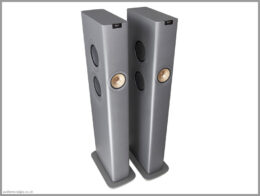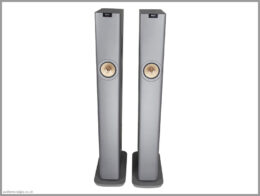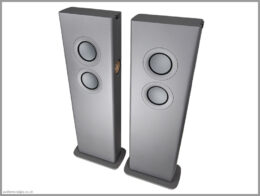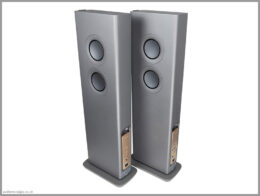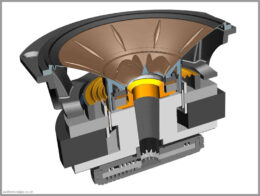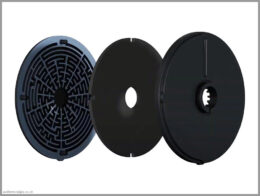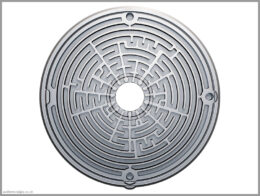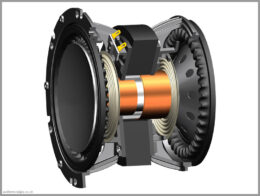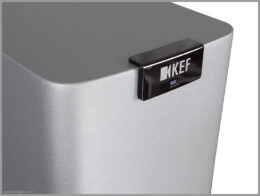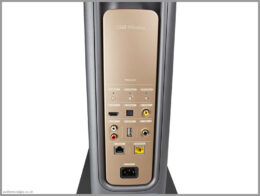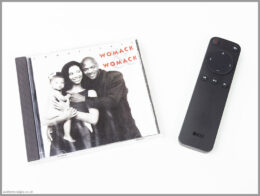TABLE OF CONTENTS
MY STORY
Even though my website started its life as a result of my passion for vintage speakers, I have a lot of respect for modern designs. I also like science and I’m curious in nature. For no particular reason, I’ve never been a big fan of Kef speakers, but I always appreciated their approach to loudspeaker design.
A good friend of mine uses KEF LS50 Wireless II as his main speakers and he has recently purchased the KEF LS60 Wireless. He has asked me whether I wanted to borrow them to do a review – how could I say no? 🙂
SPEAKER INFO
Design & Connectivity
For those not familiar with KEF products, KEF LS60 Wireless belong to the next generation of speakers. These are not only active, where each driver has a separate amplifier, but also wireless, where the audio signal could be sent to them without any cables (Bluetooth, Wi-Fi). They of course still need to be connected to the mains power supply, so the term “wireless” is a bit of a stretch. They also offer other non-wireless connectivity options, such as analogue RCA inputs, and digital inputs such as TOSLINK, Coaxial, and standard HDMI (for connections with AV equipment). And for people who enjoy really deep bass, they also offer analogue RCA subwoofer outputs (one per speaker).
More technical readers will already suspect that KEF LS60 speakers must also have a built-in digital-to-analog convertor (DAC), and they are right. In order to convert signal from digital inputs, into analogue signal that is amplified and then fed to the loudspeaker drivers, KEF LS60 Wireless have a built-in DAC. In addition, KEF also incorporated a Digital Signal Processor (DSP) controlled from the mobile app, which allows the end user to change the character of the speakers without getting up from the listening position. To accommodate analogue inputs, KEF also included a built-in analog-to-digital convertor (ADC), because the analogue input signal must first be converted into a digital signal, processed, and then converted back into analogue signal. Not sure if you’d be able to hear that, but for from technical point of view, it is better to avoid unnecessary signal conversions. As such, if you can, it is probably best to feed these loudspeakers with digital signals.
And if all of the above wasn’t enough, KEF also included a built-in streamer, compatible with most popular streaming services (Spotify, Tidal, Amazon Music, Qobuz, Deezer, QQ Music, Internet Radio, and Podcast). KEF LS60 won’t take your kids to school, but they pretty much do everything else! If you are looking for a compact all-in-one modern solution, KEF LS60 Wireless should be pretty high on the list.
Technology
Enough about electronic though, let’s talks about the drivers… on the front baffle we have a 100mm coaxial driver, with 19mm aluminium dome tweeter and 100mm aluminium cone midrange. KEF refers to it as 12th generation Uni-Q driver array with their Metamaterial Absorption Technology. This technology is claimed to absorb 99% of the unwanted sound from the rear of the tweeter. In contrast, traditional methods of absorption are claimed to only absorb 60% of the unwanted sound from the rear of the tweeter. With the exception of open-baffle type of designs, loudspeaker designers always strive to eliminate the sound waves emitted by the rear side of the drivers, in order to minimize their interference and reduce distortion. This is why we have loudspeaker cabinets, sealed midrange enclosures, and sealed tweeters. There are various ways of damping unwanted sound waves. Most loudspeaker manufacturers use various absorptive materials for this purpose, such as foam, felt, wool, fiberglass, etc. In contrast, metamaterials don’t rely on natural absorptive properties of the material, instead they use a cleverly designed shape and structure to achieve same or better results. In the case of KEF LS60 tweeter, the component responsible for absorbing rear soundwaves appears to be made of some sort of alloy and looks like a maze – very impressive! With the aid of computer simulations, metamaterials have been gaining a lot of popularity in the recent years in various industries. HiFi is not exception, and KEF LS60 Wireless are a great example of that!
For bass, we have another unusual solution – two pairs of 135mm force cancelling drivers, mounted on the sides of each KEF LS60 Wireless speaker. KEF refers to this as Uni-Core technology, where each woofer pair shares the same axis and works in the opposite direction (i.e. as one woofer comes out, the other one comes out too). Thanks to this behaviour, they cancel each other’s forces, which in turn significantly reduces cabinet vibrations. This is of course desired, as cabinet vibrations often generate distortion, and some loudspeaker manufacturers go to great lengths to completely eliminate them (i.e. Wilson Audio), whereas others try to lower their amplitude and move them down in the frequency (i.e. Harbeth).
All in all, these speakers are packed with technology and futuristic designs. The cherry on the cake is their packaging – I’ve never seen such a clever packaging design in any loudspeaker or a household item! I never thought I could get excited about the cardboard box but here we are! It’s a joy to work with and whoever created it deserves a pay rise!
KEF LS60 WIRELESS SPECS
| Frequency Response: | 31 – 24,000Hz (+/- 3dB) |
| Sensitivity: | N/A |
| Impedance: | N/A |
| Built-In Amplifier: | LF: Class D 500W, MF: Class D 100W, HF: Class AB 100W |
| High & Mid Frequency Driver: | Uni-Q 100mm (4″) Coaxial Driver with 19mm (0.75″) HF Aluminium Dome with Metamaterial Absorption Technology and 100mm (4″) MF Aluminium Cone |
| Low Frequency Driver: | 4x Uni–Core Force Cancelling Driver 135mm (5.25″) |
| Crossover Frequencies: | Unknown |
| Enclosure Type: | Closed |
| Enclosure Dimensions (HxWxD): | 1090x212x394mm (42.9×8.3×15.5″) |
| Enclosure Dimensions With Plinth (HxWxD): | 1042x130x321mm (41.0×5.1x 12.6″) |
| Weight: | 31.2kg (each speaker) |
| Production Years: | 2022 – Current |
| Price When Launched: | £6,000 for a pair |
LOOK & FEEL OF KEF LS60 WIRELESS SPEAKERS
Whenever I’ve seen pictures of KEF LS60 Wireless on the Internet, I always thought they looked rather unimpressive. I did not like the position of the driver on the front baffle, and the overall proportions seemed weird. However, when I unpacked them in my living room, my opinion changed quite a bit. I don’t exactly know why, but in person, I really like the look of KEF LS60. They look very sleek and stylish – great match for modern interiors. My wife definitely prefers their size/look over the Magnepan 1.7i.
Great number of vintage loudspeakers have front baffle width greater than cabinet depth. In contrast, most modern loudspeakers have cabinet depth that is greater than the front baffle width. Some of this is driven by design choices related to sound dispersion, however, I’m pretty sure that some of it is driven by marketing, in order to make the speakers more visually appealing. Kef designers have definitely embraced modern approach to cabinet proportions with the KEF LS60 Wireless. Their front baffle width is only 13cm, whereas their depth in nearly 40cm! I’m not too keen on these proportions, however, what these speakers miss in shape they definitely make up in style.
Loudspeaker enclosures of the KEF LS60 Wireless seem very inert and well made. They are quite heavy for their size (31.2kg each speaker), and that definitely adds to the overall impression of quality. The grey matt paint looks fantastic, and it contrasts nicely with the orange drivers and orange speaker connector plates on the back. Because the reviewed pair did not belong to me, I did not dare to ‘open them up’ to inspect the internal components. However, the visible parts of the drivers scream high-tech and precision. The only thing that stands out is the remote. There is nothing wrong with it and it is very functional, it just does not feel as special as the speakers.
Overall, KEF LS60 Wireless are very well made. They look and feel very futuristic.
SOUND OF KEF LS60 SPEAKERS
First Impressions
First impressions are usually dependent on what we listen to on a daily basis and can sometimes lead to incorrect judgments. If one is used to speakers with boosted treble, a neutral sounding speakers will sound dull on first impression, etc. Nonetheless, it is still interesting, and I do tend to report these impressions in my reviews. As my main setup, I currently use Magnepan 1.7i with two subwoofers and with parametric equalization. I’m used to balanced sound with high resolution and fairly linear but extended low end. When I connected the KEF LS60 Wireless for the first time, I immediately noticed that I don’t seem to be able to hear the atmosphere of the live recordings as easily. I also noticed that bass was quite boomy.
Bass
I was hoping that after a while I’ll be able to adjust to this bass issue, but I could not. On tracks such as Abyssinean Dub by Blue Asia the bass was unbearable. It bothered me enough for me to fire up my room measuring equipment and run some sweeps. It turned out KEF LS60 Wireless speakers activate my 53Hz room mode a lot more than a number of other loudspeakers. To illustrate the point, the 53Hz hump was 8dB higher (!) than in room measurements conducted with Harbeth M40.1, and these speakers played really low in my room. Armed with this knowledge I opened the advanced mode in the KEF app on my phone to check the speaker settings. Everything was set to factory settings, and the bass level was set to “Standard”. I’ve changed this setting to “Less” hoping that this will alleviate the problem. I’ve then rerun room measurements, and the 53Hz hump was reduced by 1dB and bass frequencies below that were reduced by 2dB to 3dB, so far from ideal. I’ve spent more time playing with different settings available in the KEF app, and after many tests I’ve found that putting the speakers in the “-9dB Wall Mode” reduces that 53Hz bass hump by 8dB. Unfortunately, the “Wall Mode” also significantly reduces frequencies below 700Hz, so I was fixing one problem by creating another. To keep the long story short, none of the KEF app settings were appropriate to help in taming this room mode. Luckily for me, I use MiniDSP SHD as my preamp, and I’ve been able to reduce the amplitude on the 53Hz hump using parametric equalisation (PEQ). I really think KEF missed the opportunity here. They already use DSP in their speakers, so why not give the end user more control by offering the PEQ the same way that Dutch & Dutch offer in their 8c speakers? I understand that most people don’t need the granular control and would be happy with the presets provided by KEF. However, for customers who’d like to have ability to fine tune their system, KEF LS60 Wireless should offer an advanced mode with Parametric Equalisation.
Normally when reviewing speakers, I don’t use the PEQ. I want to report back on the speakers as they are, because not everyone has access to Digital Signal Processing. However, the 53Hz hump in my room bothered me so much that it was distracting me from listening to everything else that these speakers can offer – and I really wanted to review them. The learning here is that if you are considering these speakers – do not buy them blind without first listening to them in your own environment.
This was a rather long intro, but I prefer to be transparent about these things. Let’s now dive deeper into my subjective perception of their sound.
The low end of KEF LS60 Wireless speakers is extended and has a very good level of details. On Loneliness House by Greg Brown the drum impact is very natural and has a lot of space around it. On the other hand, on tracks such as High Heels by Mando Diao from their MTV Unplugged album, the impact of the bass does not seem as chest pounding and not as effortless as what I’m used to. Also, there is something different in how these opposing woofers load the room. They do not seem to create as many bass pressure zones around the room. So overall, the bass seems correct but not as impactful as on larger speakers.
Midrange and Treble
In terms of midrange and treble, this is where these speakers shine. They sound very balanced and easy to listen to. Even relatively bright and sibilantly recordings such as Say My Name by Destiny’s Child are tolerable on these speakers at moderate levels. In contrast, if I played that track in my room on ATC SCM40A my ears would bleed. Thus, in the matter of forgiveness, the KEF LS60 Wireless speakers remind me of Harbeth speakers. The sound is clear but not fatiguing, even though they seem to be on the cooler side of neutral. If you prefer warmer sound, their smaller brothers, KEF LS50 Wireless II, seem to offer similar levels of clarity but with a little bit more warmth.
One thing that KEF LS60 Wireless speakers don’t do as well as the speakers I’m used to, is the low-level details in live recordings. No Woman No Cry track from the Live! album by Bob Marley & The Wailers just doesn’t seem as engaging. You don’t get as much atmosphere and the feeling of being there as with my Magnepan 1.7i. Saying that, due to their design, Magnepan loudspeakers excel in this area and most likely outperform most of dynamic speakers when it comes to reproduction of atmosphere. As such, read this comment knowing what my benchmark is. I’ve listened to a number of records on the KEF LS60 Wireless speakers and noticed that over time I was selecting a lot more studio recorded music rather than live albums. This is likely because KEF LS60 can sound fantastic on the studio recordings but not that engaging on live albums. I’m not entirety sure if this has something to do with their dispersion characteristics but for me the involvement wasn’t there. Thus, if you are thinking about KEF LS60 Wireless speakers, first consider what type of music gives you most joy.
Soundstage
What the KEF LS60 surprised me with is the soundstage height. In my experience, most traditional speakers when listened to on axis, present the performance at your head’s height (when you are sitting in you listening position). When I was playing You’re In My Heart (The Final Acclaim) by Rod Stewart from The Rod Stewart Sessions 1971-1998 album, the phantom image of his voice was above the speakers. I’m used to this experience from tall Magnepan speakers, but it rarely happens with normal dynamic speakers – very impressive. What’s not as impressive is the soundstage depth. It’s good but nowhere near as good as on Harbeth M40.1.
Human beings are much better at identifying problems than describing what sounds right. And this was my challenge with reviewing these KEF LS60 Wireless speakers. With the exception of previously mentioned bass hump in my room, KEF LS60 are very even handed, easy to listen and not offensive. There is really not much there to be critical about. Saying that, I did not particularly find anything to get excited about either…
CONCLUSION
KEF LS60 Wireless are truly all-in-one modern speakers. They are very balanced and relatively easy to listen to. They can sound very correct on studio recordings but not very involving on live recordings. Their bass extension is good, but it can also activate the room modes more than other speakers I’ve experienced. As such, if you are considering purchasing these, make sure that you can listen to them in your room before you make a decision.
| Balance of Sound: | |
| Neutrality of Tone: | |
| Transparency: | |
| Soundstage: | |
| Attack: | |
| Engagement: | |
| Total Score: |
SONGS MENTIONED IN THIS REVIEW
Blue Asia – Abyssinean Dub
Bob Marley & The Wailers – No Woman No Cry (Live)
Destiny’s Child – Say My Name
Greg Brown – Loneliness House
Mando Diao – High Heels (MTV Unplugged)
Rod Stewart – You’re In My Heart (Acoustic Version)
Reviewed: October 2022 | Published: November 2022


